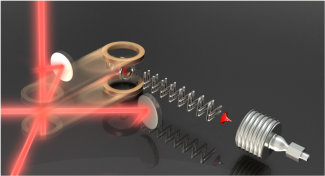Cold atom-molecule collisions are studied in a co-trapped environment. Rubidium atoms are laser cooled before being trapped in a quadrupole magnetic trap. A cold beam of neutral ammonia molecules (ND3) or hydroxyl radicals (OH) is produced via supersonic expansion and decelerated using a Stark decelerator before being trapped in an electrostatic trap. To initiate interactions, the coils forming the magnetic trap for atoms is translated across the optical table so that the trapped samples of atoms and molecules overlap. The dynamics of the combined system is monitored by measuring the density distribution of molecules using a resonance-enhanced multi-photon ionization scheme to state-selectively ionize the molecules for subsequent detection using a multi-channel plate detector.



 The Physics Frontiers Centers (PFC) program supports university-based centers and institutes where the collective efforts of a larger group of individuals can enable transformational advances in the most promising research areas. The program is designed to foster major breakthroughs at the intellectual frontiers of physics by providing needed resources such as combinations of talents, skills, disciplines, and/or specialized infrastructure, not usually available to individual investigators or small groups, in an environment in which the collective efforts of the larger group can be shown to be seminal to promoting significant progress in the science and the education of students. PFCs also include creative, substantive activities aimed at enhancing education, broadening participation of traditionally underrepresented groups, and outreach to the scientific community and general public.
The Physics Frontiers Centers (PFC) program supports university-based centers and institutes where the collective efforts of a larger group of individuals can enable transformational advances in the most promising research areas. The program is designed to foster major breakthroughs at the intellectual frontiers of physics by providing needed resources such as combinations of talents, skills, disciplines, and/or specialized infrastructure, not usually available to individual investigators or small groups, in an environment in which the collective efforts of the larger group can be shown to be seminal to promoting significant progress in the science and the education of students. PFCs also include creative, substantive activities aimed at enhancing education, broadening participation of traditionally underrepresented groups, and outreach to the scientific community and general public.